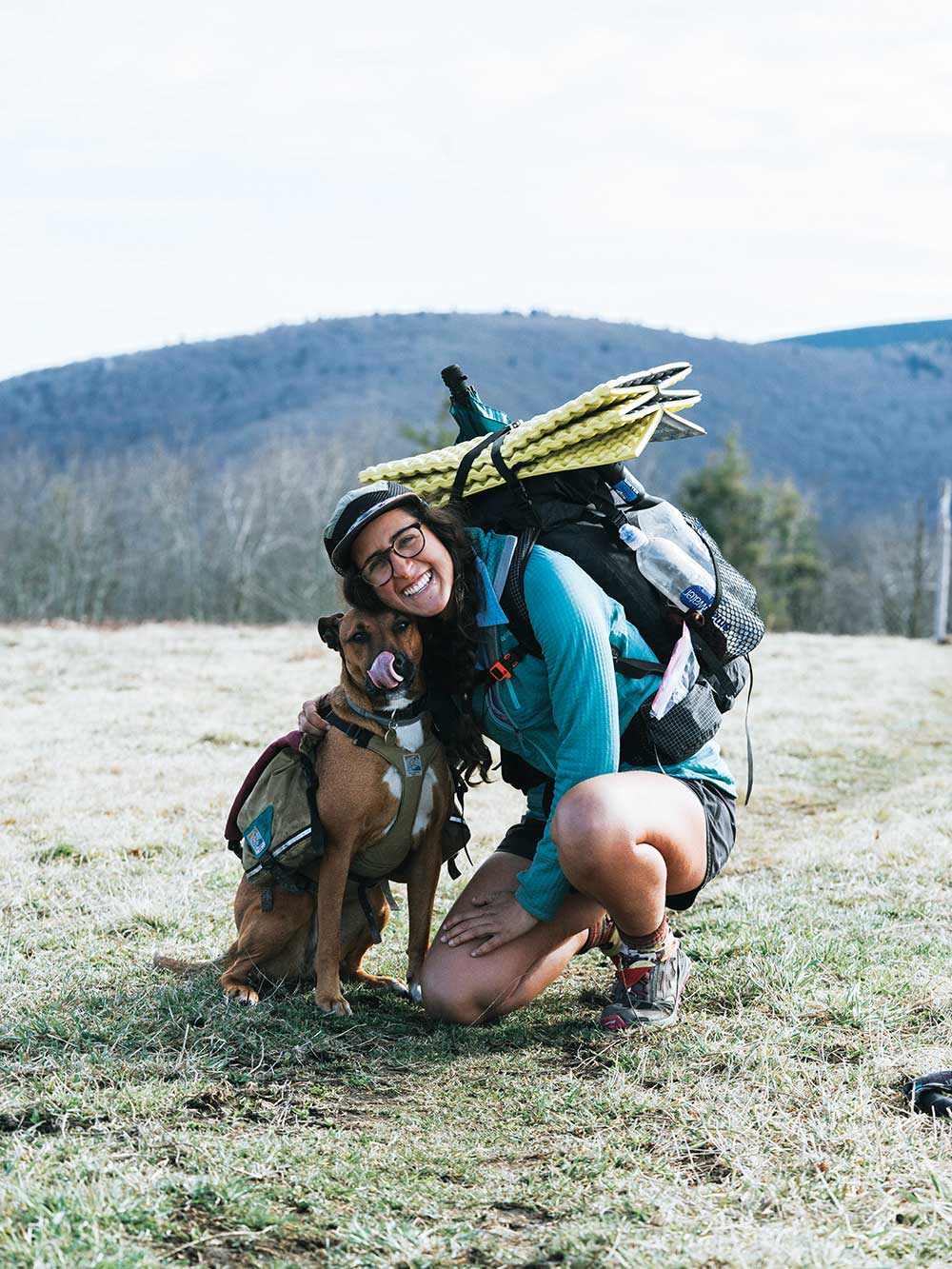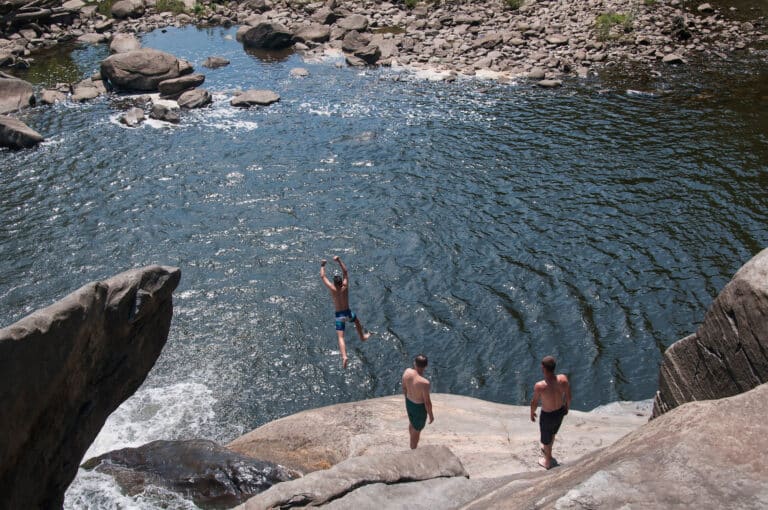When Grizel Williams decided to thru-hike the Appalachian Trail with Rue, her 3-year-old rescue dog, she knew a lot of people would have an opinion about her decision.
“There are people that are really excited about me and Rue, and then people who think I’m abusing my dog,” she said. “I know that it’s the right thing, but a lot of people don’t think so. It’s a constant battle every day because there are so many people on this trail. But when I go to bed at night and I see her little face and I know she had the best day of her life today, I feel like I’m doing a good job.”
Williams thru hiked the Pacific Crest Trail southbound in 2018, leaving Rue behind for the four months she was gone.
“It was really lonely on the PCT,” she said. “It was so freaking lonely and hard. I missed Rue so so much. Even though I was pretty lonely, I loved what the trail brought out in me and this person I became from it. I got the thru-hiking bug. I thought if I do the A.T., there’s no way I can’t bring Rue to have a companion with me to talk to and cuddle with at night.”
Having already done a thru hike made the decision to bring Rue along easier.
“If that was my first thru-hike, I wouldn’t have taken Rue,” Williams said. “I was going through too much on the PCT to worry about Rue. But now that this is my second thru hike, I know what to expect from my body so I can focus all my energy on Rue and make sure she’s okay.”
Rue has always been an athletic dog who is happiest running around outside.
“She gives me so much joy,” Williams said. “I guess I wanted to give her the same amount of joy that she brings me.”
Although she had taken Rue on shorter day hikes and weekend camping trips, a thru hike would be a completely different experience.
“Thru-hiking is its own world,” Williams said. “I didn’t even thru hike until I thru-hiked. You can’t prepare yourself enough, so I didn’t expect to prepare Rue for a thru-hike either. I trained her a lot, but that’s as far as I went.”
In their training, Williams focused on commands she would need Rue to follow when they were on the trail together. In addition to loose leash and heel training, they also worked on the leave it command so that Rue would pay attention when they came across other wildlife.
“I’ve gone through a lot with her,” Williams said. “When I first got her, she had some aggression issues and I had people tell me to put her down. But we’ve worked a lot on that. I get nervous to talk about that stuff because a lot of people have issues with dogs who struggle with stuff. But I feel like if we can believe in humans, why can’t we believe in dogs’ recovery as well?”
There is not a lot of information about how to train a dog for a thru-hike, so Williams made up a lot of it as she went.
“I’m not going to say that dogs are like people,” Williams said. “I know that they’re different. But the same way that there are so many opinions on how to raise a child, there’s a lot of opinions on how to train a dog and how to take a dog on trail. If you want to take your dog and you feel like you’re being completely honest with yourself that you think that your dog could do this, follow your gut. You’re going to get a lot of hate, like I have. You have to trust yourself and kind of forget the haters. You know your dog better than anyone else ever will.”
Before leaving on the trip, Williams got the okay from a veterinarian that Rue was ready for life on the trail.
“It’s a really emotional bond I have with Rue,” she said. “I was told to give up on her, but I didn’t, because she’s never given up on me. To be told by a vet and dog trainers that she could do this, that she was trained well enough to hike the Appalachian Trail, was one of the biggest victories for us. As much as I want her here, it’s important that she’s enjoying it and her temperament is right for the trail.”
On Their Way
The dog and hiker set out from Georgia on March 9. At their current pace, Williams estimates they will finish the 2,100+ mile trail sometime in July.
“Thru-hiking is a weird sport where you push yourself a little bit more than feels comfortable at first,” she said. “In the beginning, I didn’t know how to do that well with Rue. At first, I was playing the caution card to learn what Rue is like on the trail. The beginning of a thru-hike is all about testing out things.”
Williams carefully watched Rue, looking for signs of her slowing down or waking up with less energy. Some days Rue wore her Groundbird Gear pack and some days Williams carried it with her own pack. Some days they wouldn’t hike at all in order to give Rue extra time to rest.
As spring began to warm up, Rue began struggling with the afternoon sun and heat. Williams knew something had to change if she wanted to keep her dog on the trail. So, she started waking up at four in the morning to be off the trail before the afternoon hit.
“I hike Rue’s hike,” Williams said. “As much as it is about me learning and growing as a person, which I still feel like I’m doing, I cannot push myself as much as I would want to on my body because that’s not fair to Rue. That’s why this is such a bonding experience because I’m constantly making sure that she’s happy. If she’s not happy, what is the point of this whole thing to do with her? She has nothing to prove. Whatever I decide is going to affect her.”
Hiking with Rue also means Williams has been a little more disconnected from the rest of the thru-hiking community.
“A lot of people are scared of dogs and that’s totally fine,” she said. “I respect people’s fears. Because of that, we have to isolate a lot and stay to ourselves more. You don’t know what people’s journeys have been with dogs. Some people have been bit by dogs. People are sacrificing so much to complete a thru-hike that I don’t want to interrupt anybody else’s journey.”
There are also a few places along the A.T. that don’t allow dogs on the trail, like the section that runs through the Smoky Mountains. For those miles, her partner picked Rue up and Williams hiked solo for a few days. They met back up where dogs were allowed again.
“It kind of felt like a huge missing piece,” Williams said. “As soon as she left, I did these 27, 30-mile days. These crazy miles. That’s how I deal with my emotions.”
In the time she was by herself, Williams said she noticed the ways she was hiking differently without Rue.
“She’s so good at stopping and smelling things and being so present,” Williams said. “I can kind of get carried away and do a shit ton of miles unnecessarily. So, for her to be like hey, look at this flower that I’m smelling for way too long. Or look at this piece of shit I found on the trail. She’s so good at slowing me down.”
At the beginning of May, she made the decision to take Rue off trail. They were almost to the halfway point in Harper’s Ferry, but Williams could tell Rue was struggling with the heat.
“I promised myself I would stay honest throughout this process, simply because I love her too much,” Williams wrote on Instagram. “I feel a multitude of emotions—sad, relieved, confused—but mostly proud. I just want to say a special thanks to everyone who has supported Rue throughout this whole journey. It has been such a beautiful and bonding experience that I’ll never take for granted.”
Although Williams will finish the A.T. without Rue, there are many more adventures to come for the two best friends as they enjoy the trails and each other together.
Advice from Grizel and Rue
Stop at every water source along the way: “I sleep with an extra liter and a half of water because she gets really thirsty after dinner. Most dogs don’t drink enough during the day so at night they are storing up.”
Be aware of your surroundings: “I don’t use headphones when I’m hiking with her because I want to be able to hear things before anyone else.”
The Best Life a Dog Can Have
Growing up, Cherisa Hawkins’ family always had boxers. She started working with Atlanta Boxer Rescue because she loved the breed so much.
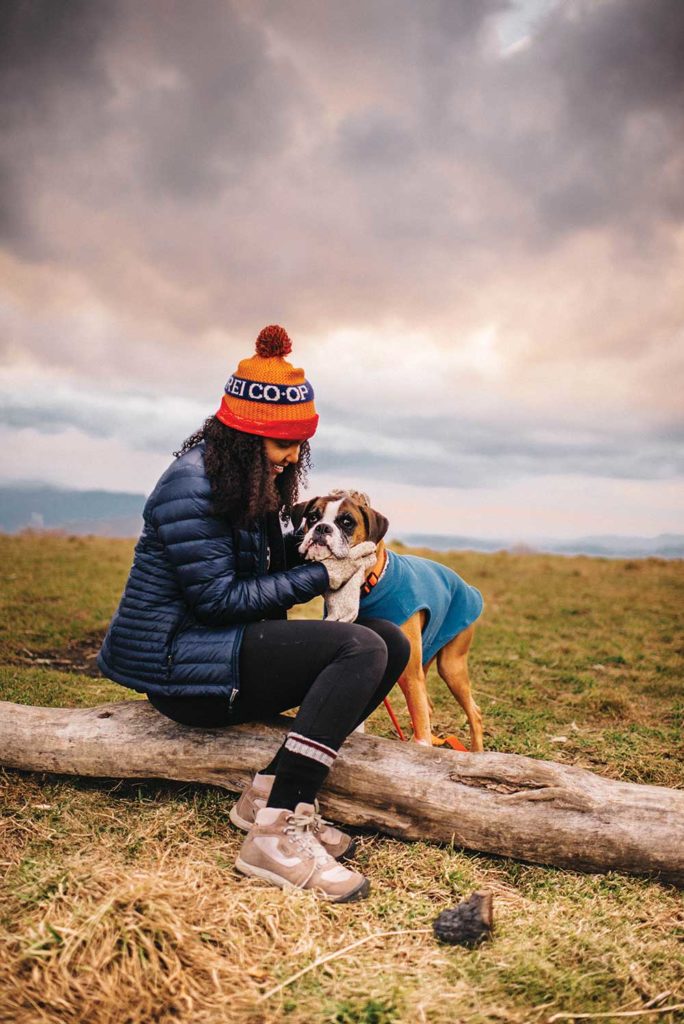
“Rocko was my third foster working with them,” she said. “When I picked him up from the animal shelter, he was 45 pounds. He was completely emaciated. He didn’t have any energy, so I had to hand feed him the first night. I think that’s where we really bonded. Just for me, having to give him the extra love and attention, he got really attached to me and I got really attached to him. I decided to keep him.”
Boxers are a social breed and Hawkins discovered Rocko enjoyed playing outside.
“I want to give him the best dog life he can have,” she said. “A part of that is being outdoors and being free when he has the chance.”
Hawkins started watching YouTube videos on how to teach Rocko the come command. She reinforced that training with treats and positivity on the trail.
“When we first started hiking, we only hiked in the city,” Hawkins said. “We hiked around the Chattahoochee and within the perimeter of Atlanta so there were no major hills or switchbacks that he had to do. I tried to train him like I would train my own body. They just can’t jump into it and go. Every winter when we start hiking again, he has to condition just like I do.”
Because of his breed, Rocko has a shorter nose and wider chest. Hawkins said she usually takes him out in the spring and fall since he can overheat easily.
“When we do hike in the hotter days, I have to be very careful to make sure I take trails that are located along water,” she said. “I’m always on a trail where I can stop by the river to let him get in the water and cool off. He suffered from heat stroke about three years in from me having him. That was a very expensive experience. So, I’ve just learned that if it’s too hot, he doesn’t go.”
Since Rocko experienced that heat stroke, Hawkins knows the signs to look for. When she notices his ears turning pink underneath, his gums getting red, or excessive panting, she knows it’s time to cool down.
As long as it’s not too hot, Rocko will carry his own Ruffwear pack with food and other supplies. Hawkins makes sure the pack weighs no more than a third of his body weight.
“When he sees it, he gets really excited,” she said. “He knows he’s going to hike.”
When she’s camping close to home, Hawkins will bring Rocko along so he can spend more time outside.
“I’ve learned over time what he does and doesn’t like about camping,” she said. “I have to tailor it to make sure I fit his needs. I carry just about as much stuff for me as I do for him. He loves camping in spring, summer, and fall. He does not like it when it gets cold. He’s not a fan, even in his fleece vest, boots, and doggie puffer jacket. He prefers to stay in the tent and doesn’t want to move.”
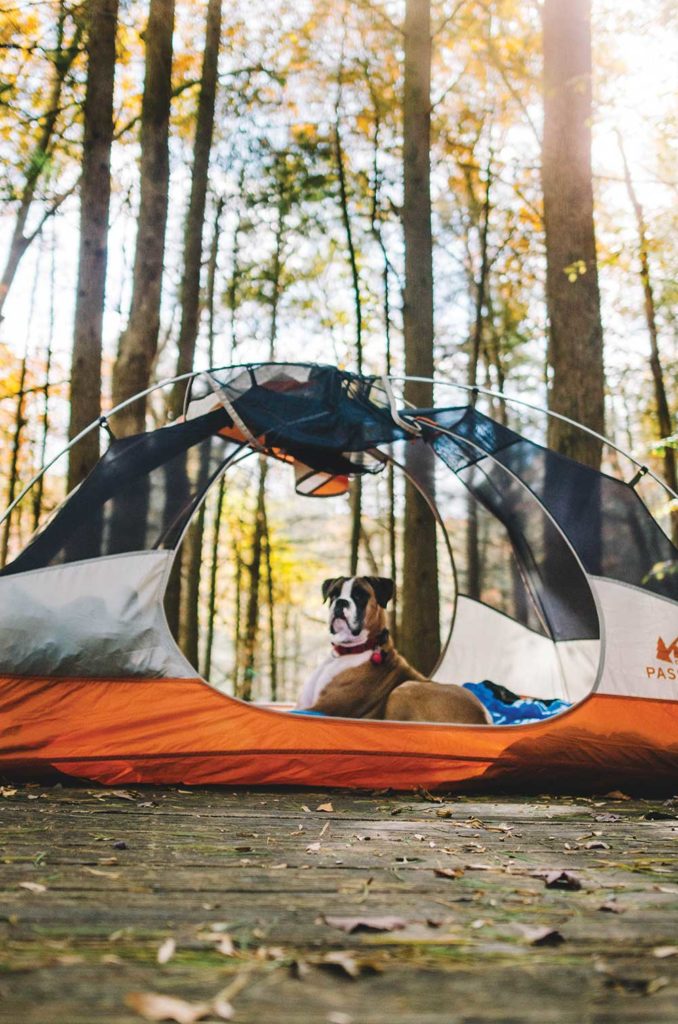
Last fall, Rocko went on his first extended camping trip in a van from Atlanta to the Asheville area.
“I think he may have preferred that over camping a little more because he was able to have his own corner in the van where he could curl up and go to sleep,” Hawkins said. “I didn’t have to worry about him being too cold or too hot or tired or sore. It was nice having him as an extra blanket of security, which is why he camps a lot with me. He’s the additional comfort I have with me when I’m out by myself.”
After that experience, Hawkins said she hopes she’ll be able to take Rocko on more longer camping trips.
“Before he gets too old, I want to do a cross country road trip so that he can go with me from start to finish,” she said. “I do get sad when I go to California to camp and I don’t have him. I just really miss him a lot.”
Advice from Cherisa and Rocko
Know their trail personality: “When they’re on the trails, they’re going to be different than when they’re at home. When he’s on the trail, he gets to eat a little more of a fatty diet. He gets a little more possessive of me on the trail. It’s just giving your dog time to adjust to being outside, especially if they’re house dogs.”
Do your research: “It’s best to know the terrain, know their allergies, and just start slow.”
All Pets Are Welcome
When Laura Moss first started Adventure Cats, she had no idea she would one day have almost 150,000 followers on Instagram.
“I noticed a trend of more and more people taking their cats out on adventures, and I was curious about how people went from basic leash training to taking their cats on road trips, camping, and hiking,” she said. “I started talking with cat owners, veterinarians, and behaviorists and putting it together as an informational resource for anybody to have access to. It got a lot more attention than I ever expected. I realized there were so many more people than I even knew about who were taking their cats on these adventures.”
In addition to maintaining the website and social media accounts with her husband, Cody Wellons, Moss also wrote Adventure Cats: Living Nine Lives to the Fullest. The book is a mix of inspiring cat stories, photographs, and tips for other cat owners.
“I’ve gotten to travel a lot and go on hikes with cats all over the country,” Moss said. “I’ve met cats paddleboarding and camping. There’s a cat in Hawaii that surfs. There are a couple cats in Colorado who go rock climbing, both outdoors and in the climbing gym. It just depends on the cat and what they become comfortable with.”
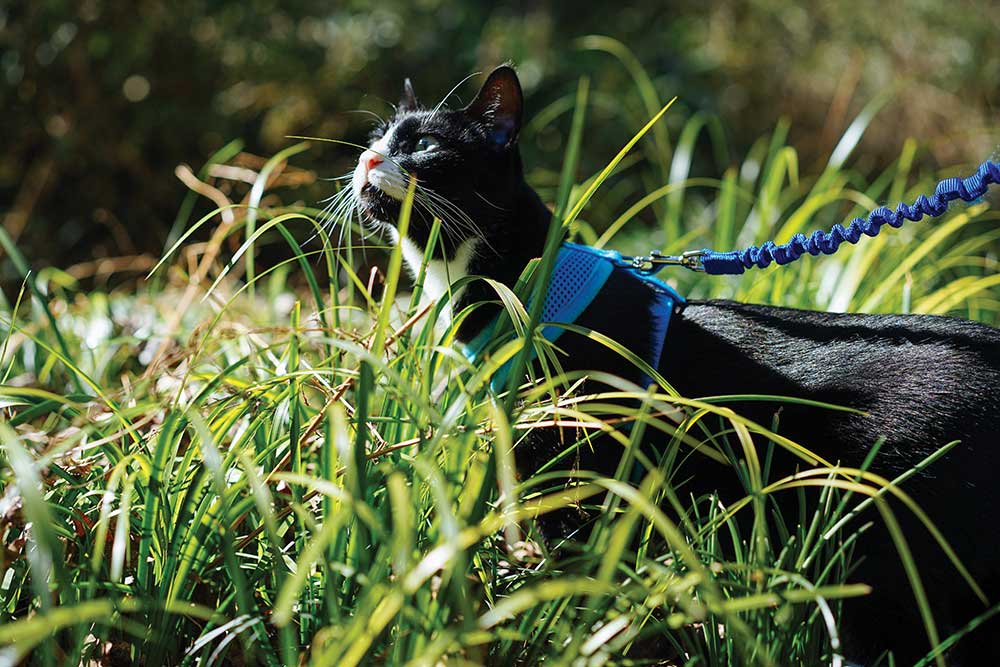
Moss and Wellons have adopted two cats, Fiver and Sirius Black, and a dog, Maeby. Moss trained the cats when they were older, so they are not as comfortable on longer trips. But they enjoy walking around the neighborhood as “close to home adventure cats.”
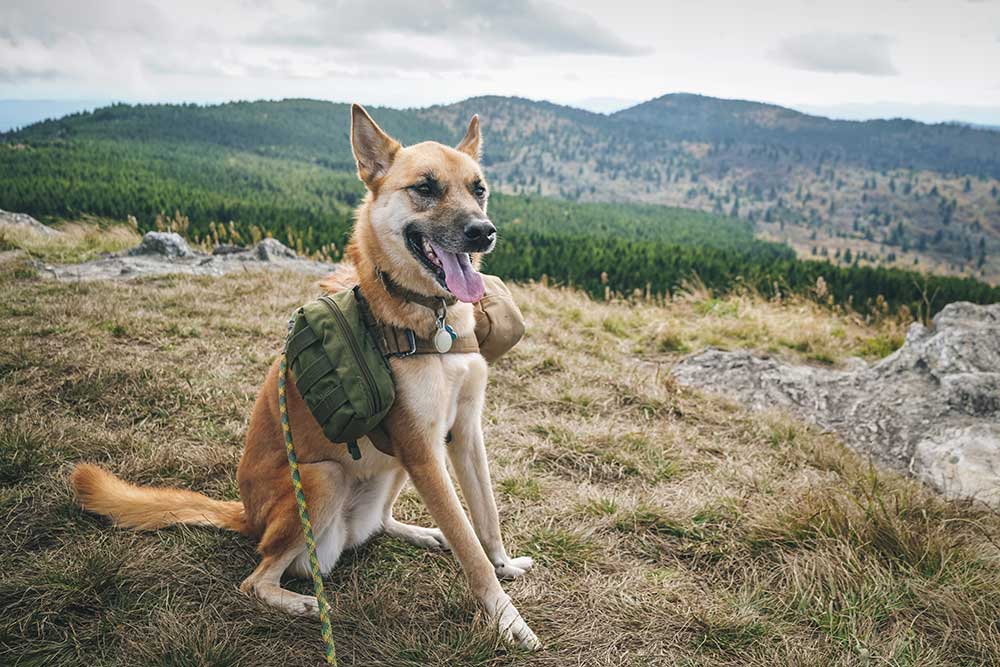
“Sirius was very easy to leash train,” Moss said. “We put him in it, and he was ready to go. Fiver is a bit more standoffish and very stubborn. We started him off by putting his harness by his food bowl or putting treats on it, so he started making that positive connection each time. With cats, it’s got to be positive reinforcement. That’s how they learn. The first time we put him in the harness, we gave him more treats so you’re always leaving on that good note.”
When it comes to training a cat, Moss said it often comes down to personality.
“Some cats aren’t going to be as comfortable outdoors in an unpredictable environment,” she said. “But I think we underestimate what cats are capable of. A lot of people make this assumption that cats sleep 16 hours a day. When cats are in the wild, they don’t sleep that often because they’re hunting, exploring, playing. I think our cats aren’t engaged enough.”
There are many different ways cats can get outside, from hiking with a leash to a walk around the neighborhood in a stroller. Moss emphasized that how cats are getting outside isn’t as important as if they are getting outside.
“We want to rebrand cats in a way,” she said. “There are all these negative stereotypes that we buy into like the crazy cat lady. Men are hesitant to adopt cats because they think it’s a feminine thing to do. So, part of what we want to with Adventure Cats is change people’s minds about what cats are capable of and what cat people are like. We really hope by doing that, we can get more cats adopted in shelters.”
Moss recommended taking cats out in the mornings or evenings when they are less likely to become dehydrated or sunburned. She also uses the American Red Cross Pet First Aid app to deal with any emergency situations that may arise.
Advice from Laura and her adventure cats
Carry your cat outside: “If you’re going to take your cat outside on the leash, you always want to carry your cat outside. You don’t want your cat to get used to walking out the door on their own because they might do that without a harness one day.”
Watch their water intake: “Cats don’t drink like we do, or dogs do on a hike. You want to prevent dehydration, so one thing you can do is bring canned wet food because cats are more likely to take in water that way.”
More Adventure Pets!
Adventure is not just for our larger, furry friends. Angus and Moody are a pair of hedgehogs who love to explore.
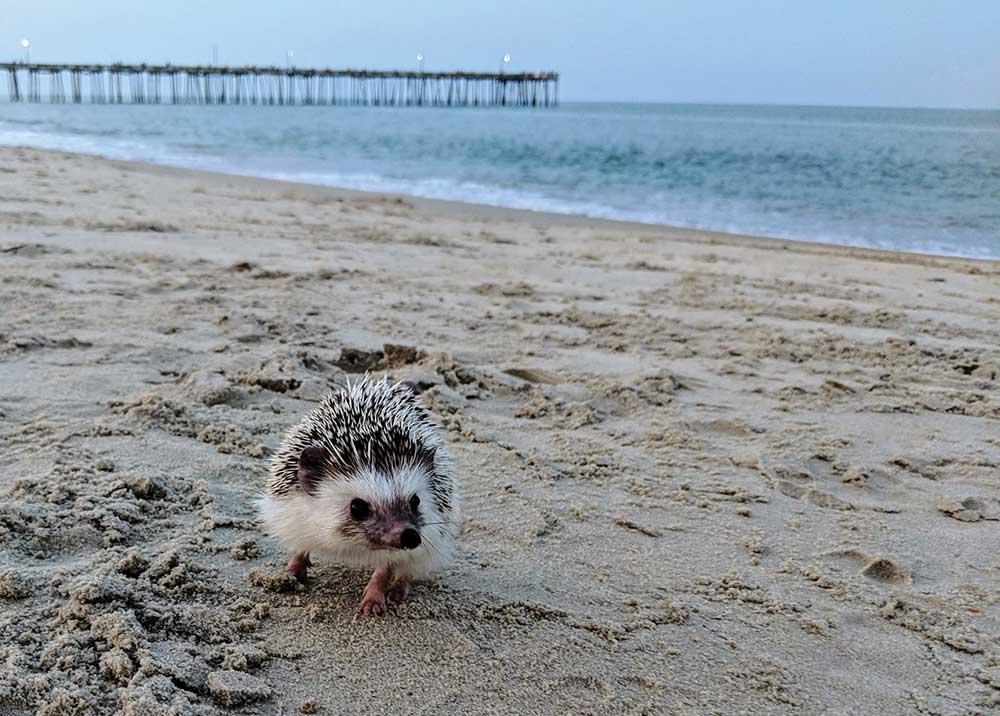
“My goal is to one day have a farm and have all kinds of animals,” said owner Noelle Faria. “We’d previously had guinea pigs, but my husband was very allergic to them. I was researching pets that are more friendly to people who have allergies and hedgehogs are one that do really well. Since they have the quills, they don’t have the dander that most small, furry animals have.”
The Farias adopted Angus in the summer of 2017. A year later, Moody joined the family when Faria saw an adoption posting in one of the online hedgehog communities she joined.
While the hedgehogs aren’t going on long hikes and overnight camping trips, they are exploring the Farias’ fenced-in backyard.
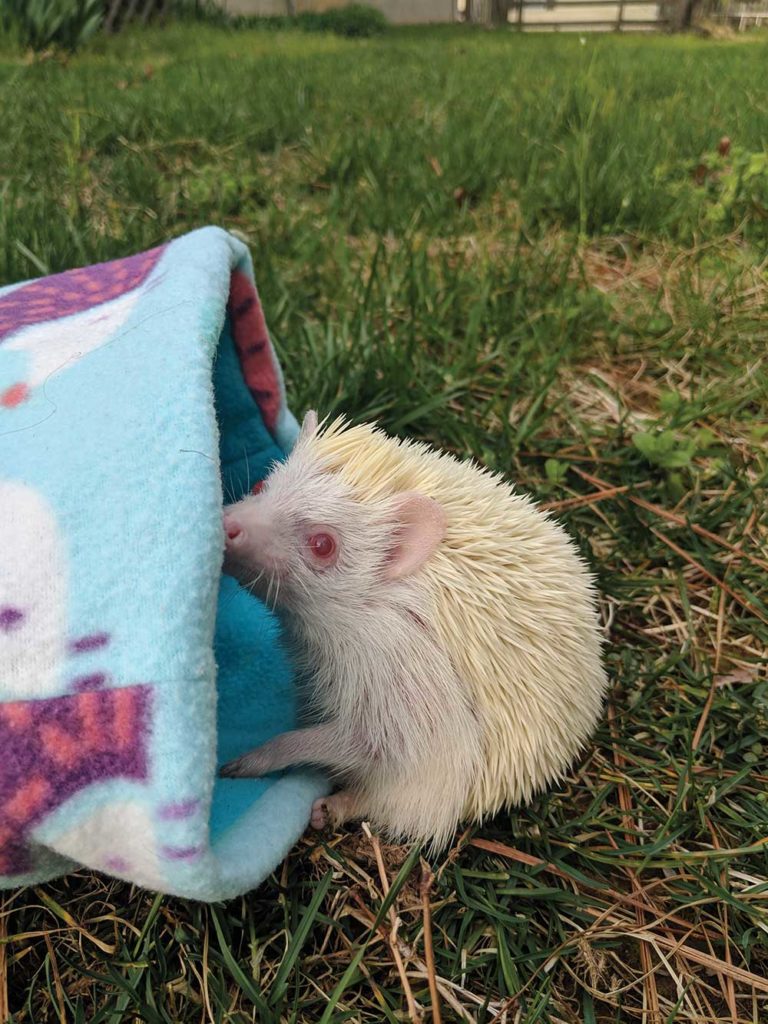
“I had read that in the wild hedgehogs have been tracked to run 5 miles in a single night, which is pretty impressive considering just how many steps that would be for their tiny stature,” Faria said. “Curious, I installed a bicycle odometer on Angus’ wheel to see just how far he was running. Sure enough, he hit around 4 to 6 miles each night.”
Angus has made it out to the beach on a family vacation and Faria said she hopes to get Moody out there as well.
“Hedgehogs are super sensitive to temperature,” she said. “Their enclosures are kept between 72 and 80 degrees. If they get below that, they can go into hibernation and that can be really dangerous for them, even lethal. But going to the beach in the summer, there really wasn’t a big concern with that. It was a great opportunity for me to let him get out in the outdoors and explore a little bit.”
At home, Angus and Moody do most of their exploring in the evenings because hedgehogs are nocturnal animals.
“They’re not going to be active during the daytime,” Faria said. “Usually when we hang out with our guys is around dusk because that’s more likely when they’re waking up and want to interact with you. They are definitely more of a niche pet but they’re really sweet animals and for the right person, I think they’re really great pets.”
